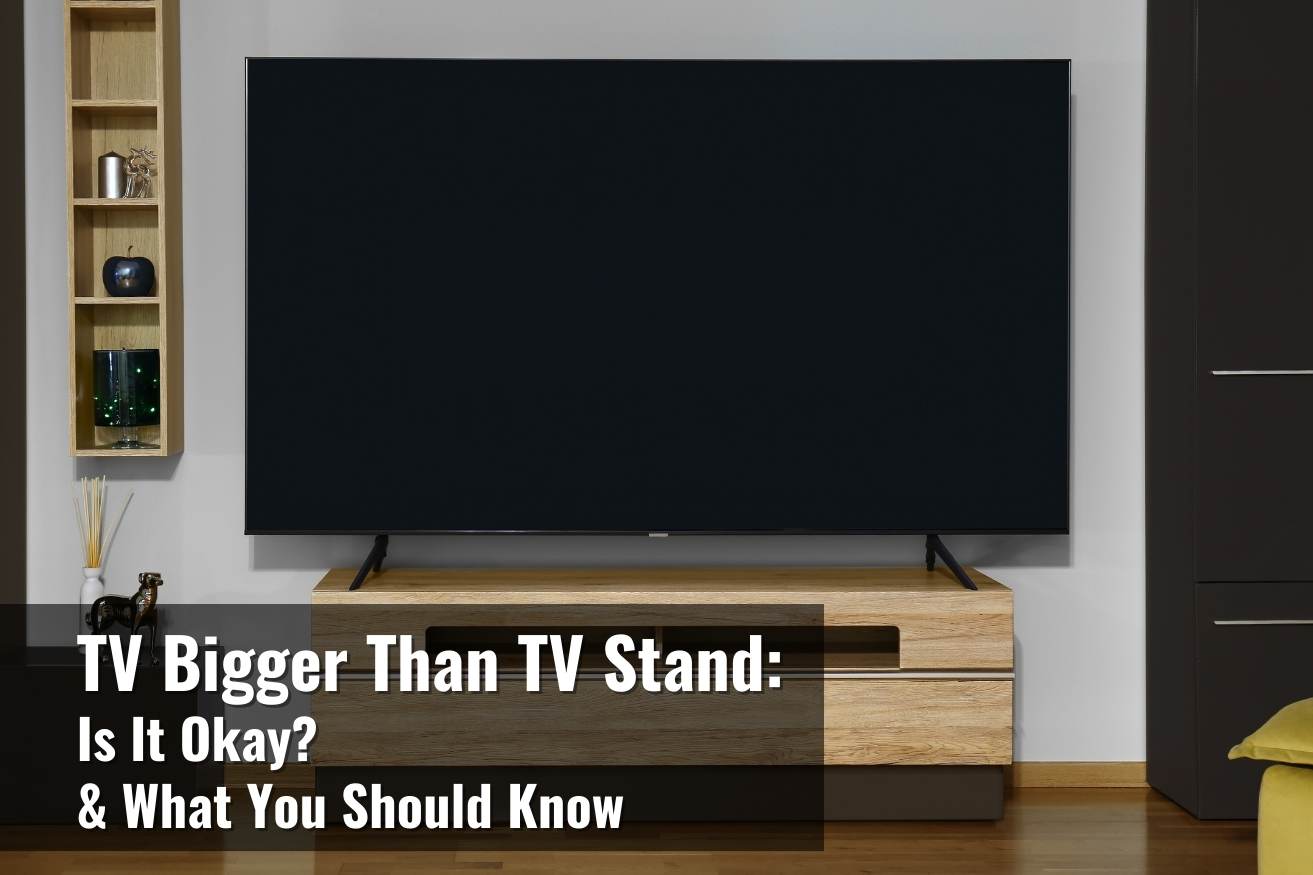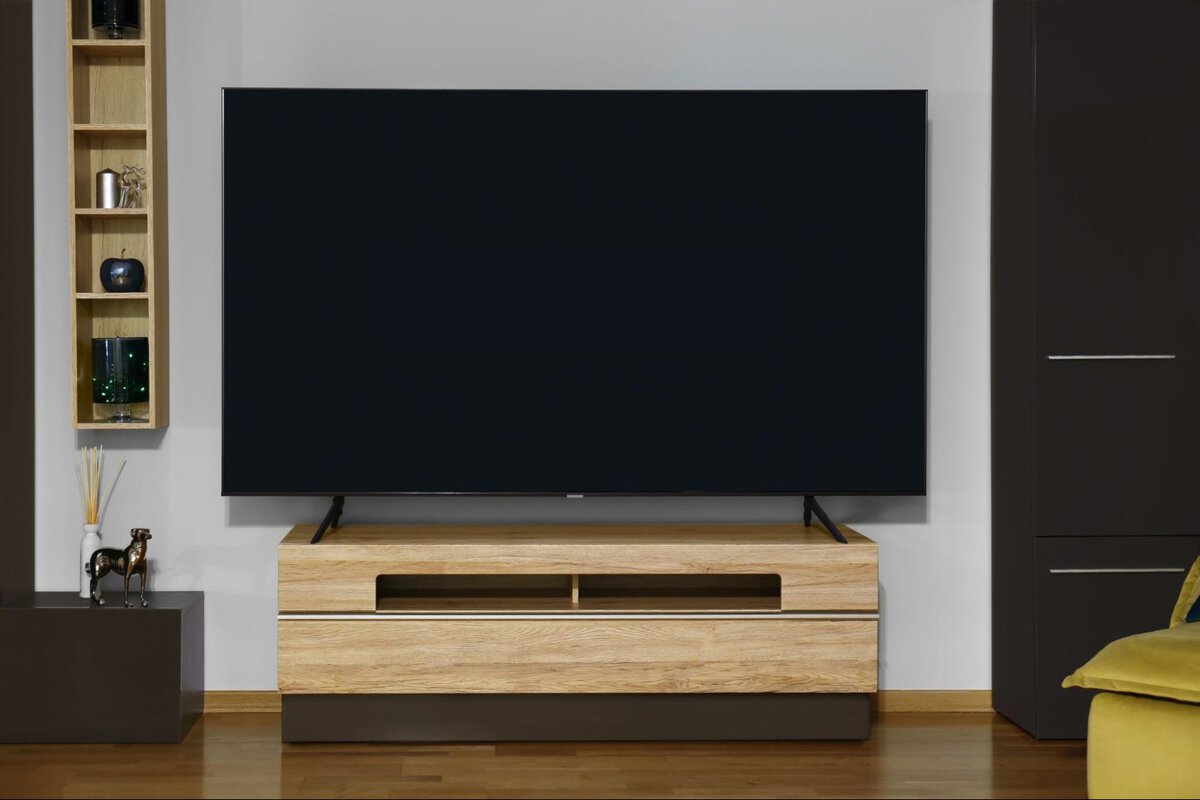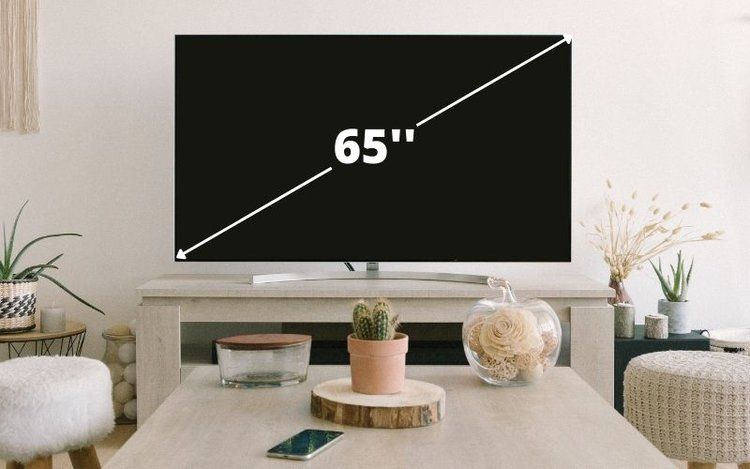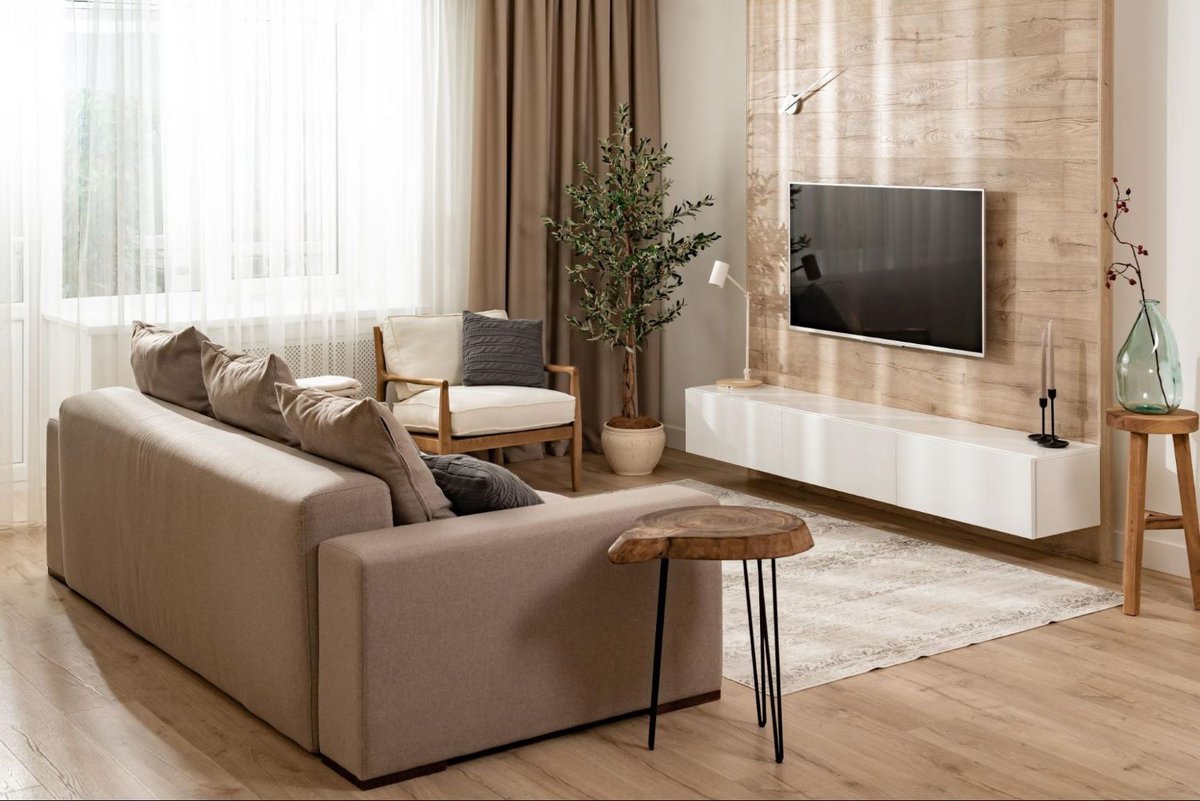TV Bigger Than TV Stand: Is It Okay? What You Should Know

What To Know
- A TV stand that is smaller than the TV risks instability, while a larger stand offers more support and is generally preferable.
- The ideal TV stand should be about 3 inches wider than the TV, and its height should be based on the viewer’s average sightline for comfortable viewing.
- Small stands, measuring 42”, 54”, and 60”, fit 34″ to 63″ TVs beautifully.
Medium stands, ranging from 64” to 70″, are ideal for TVs between 55″ and 73″.
Large stands, available in sizes 74″, 76″ to 85″, are great for TVs that are on the bigger side, specifically those measuring 63” to 73”.
In this article, I’ll guide you through a common dilemma many face: whether it’s okay for your TV to be bigger than your TV stand, or the other way around.
Read on for all the essential insights you need to make the best choice for your entertainment setup.
Quick Navigation
Is It OK That My TV Is Bigger Than My TV Stand or Vice Versa?
Yes, it’s OK, but there’s a small catch.
A small stand leaves your TV’s sides, especially its delicate edges, more exposed to accidental knocks and potential damage.

Having a larger stand not only complements your TV but also offers better protection against unintended bumps.
If you’re placing your TV on a stand, opt for a larger one.
This isn’t just about looks – it’s practical too.
When mounting your TV on the wall, the size of your TV stand isn’t crucial.
However, choosing a larger stand can significantly boost your room’s aesthetics.
I’ve found that a stand bigger than the TV adds a stylish touch to the room’s vibe.
How to Measure Your TV for a TV Stand?
Did you know that TVs are measured from the bottom-left corner to the upper-right corner?
If you didn’t, you’ve probably been measuring your TV wrong all this time.

TVs are measured diagonally, which means the numbers advertised on TV only represent the diagonal size of the TV screen. It doesn’t include the width of the frame.
To choose the correct TV stand, we should take into account the total width of the TV, with the frame included.
Once you have the size, write it down so you don’t forget. You can take notes with you when you go stand shopping!
Here are the TV sizes and their measurements:
| Size |
Measurement |
|
32” |
27.9” x 15.7” |
|
40” |
34.9” x 19.6” |
|
43” |
37.5” x 21.1” |
|
50” |
43.6” x 24.5” |
|
55” |
47.9” x 27.0” |
|
60” |
52.3” x 29.4” |
|
65” |
56.7” x 31.9” |
|
70” |
61.0” x 34.3” |
|
75” |
65.4” x 36.8” |
|
80” |
69.7” x 39.2” |
|
85” |
74.1” x 41.7” |
Quick Tip: A good rule for TV viewing is to sit about twice as far away as the screen’s size. So, for a 60-inch TV, it’s best to watch from at least 120 inches away.
How To Find the Right TV Stand?
Besides measuring your TV before making a purchase, there are other things you need to do to find a suitable TV stand.
Consider the following:
Height
Watching a two-hour movie with your neck arched isn’t exactly the most comfortable experience.
Neither is slumping over on the couch.
Therefore, finding the right TV stand height is essential to ensure a comfortable watching experience.
Getting these measurements is simple:
Step 1: Using a measuring tape, measure the distance between the floor and the average sightline of the people in your home while sitting down.
Step 2: Subtract half of the TV’s height from that number. The result should be the perfect TV stand height for viewers.
Width
TV stands are measured horizontally, not diagonally.
A good rule of thumb is to choose a TV stand that is a few inches bigger than your TV, preferably at least 3 inches.
Your TV shouldn’t be bigger than two-thirds of your stand.
Placement In Your Room
Finally, if you can choose where to place your TV, keep it away from heating or cooling vents and windows. This helps avoid glare from direct sunlight.
Ideally, position your TV against a wall without blocking access to areas like the front of windows.

Consider safety if you’re thinking about putting your TV in the center of the room.
If it’s too large for its stand, it could easily be knocked over.
It’s safer against a wall, where it’s less likely to be bumped.
For small rooms with large TVs, consider wall mounting with floating shelves instead of using TV stands. This frees up space and makes your room feel bigger.
If your room is compact, a corner TV stand can be a great space-saving choice, making the most of an unused corner.
What Are the Common TV Stand Sizes?
TV stand manufacturers typically come up with general guides to help customers find the right size stands.
Still, keep in mind that these measurements are just estimates. You shouldn’t rely on them too much.
Instead, take all the measurements yourself and bring your notes when you shop.
Now, here are the common TV stand sizes on the market:
Small Stands
Small TV stands are suitable for small televisions in bedrooms. These compact stands don’t occupy much space, so they ensure the room is not cramped or overcrowded.
Common Sizes: 42”, 54”, and 60”
Best for: 34 to 63-inch TVs (measured diagonally).
Medium Stands
TV stands of these sizes can boost the style and practicality of living rooms and larger bedrooms, providing valuable storage space.
Common Sizes: 64” to 70”
Best for: 55 to 73-inch TVs (measured diagonally).
Large Stands
Large TV stands are ideal for bigger televisions or spacious living areas, home theater, and entertainment centers.
They provide plenty of room to store different items and a tidy way to conceal messy cables. Plus, they provide plenty of room to display decorative pieces.
Common Sizes: 74″, 76″ to 85″
Best for: 63” to 73” TVs (measured diagonally).
How Much Bigger Should My TV Stand Be Compared to My TV?
When choosing a TV stand, it’s a good idea to pick one that’s at least 3 inches wider than your TV. This extra space ensures your TV fits comfortably and looks proportionate.
If you stumble upon a stand that’s bigger but catches your eye with its design, go for it!
Just remember, a stand smaller than your TV might not work well unless you’re planning to place it under a wall-mounted TV.
I learned this the hard way when I ended up with a stand too small for my living room setup!
FAQs
Is It Safe To Put a 55-Inch TV on a 50-Inch TV Stand?
Putting a big TV on a stand that’s too small can be really risky. It’s safer to choose a stand that’s bigger than your TV.
I once had a TV that barely fit on its stand, and it always felt like it could tip over at any moment.
A larger stand not only looks better but also keeps your TV stable and safe.
What Size TV Can Fit a 40-inch Stand?
Opting for a TV stand that’s 40 inches wide means it’s best suited for televisions up to 44 inches wide.
I’d advise choosing a TV slightly smaller than this limit in case something unexpected happens.
It ensures a more stable and secure setup, as pushing the size to the maximum can sometimes be risky for your TV.
Final Thoughts
It’s better to get a wider TV stand than your TV by a few inches. Yet, it’s not recommended to get a smaller rack than your TV.
Stands too small for your TV increase your TV’s risk of tipping over and falling to the ground.
If storage space is what you’re after, smaller stands might not have what you’re looking for.
Determine your TV’s exact width, so you can find the best TV stand to pair it with.
Meet Vance. He’s a proud dad, a seasoned Electronics Engineer, and an avid tech lover. His proficiency in electronics and troubleshooting skills were instrumental in crafting Pointer Clicker. Vance is passionate about simplifying tech for those who aren’t well-versed in it.


